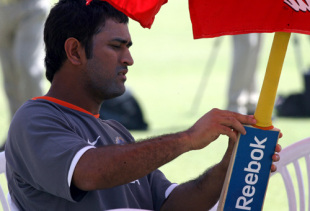MCC changes law on bat handles
MCC members have voted almost unanimously in favour of re-writing Law 6 to ensure handles are made primarily from wood, cane and twine
Cricinfo staff
08-May-2008

| ||
In an effort to bring about an even contest between bat and ball, MCC members have voted almost unanimously in favour of re-writing Law 6 to ensure handles are made primarily from wood, cane and twine. With a two-thirds majority needed to pass the change, 98.6% of members at a special general meeting were in favour of protecting the make-up of the bats.
The alteration has been brought in to stop the extra power gained by players when the handles contain substances such as carbon. A bat used previously by Ricky Ponting has been banned while another Matthew Hayden trialled does not fit the specifications.
"The new Law stipulates that 90% of the volume of bat handles should consist of cane, wood and twine, with the other 10% for the purpose of reducing vibration, for example rubber," an MCC spokesman said. "It states bat handles, including the splice, must not exceed 52% of the overall length of the bat, and restricts the thickness of materials that can be used to protect and repair bats."
John Stephenson, MCC's head of cricket, said the law had to be changed as the members felt batsmen had an unfair advantage. "In cricket, the battle between bat and ball is key," Stephenson said. "If one comes to dominate the other, the game will become predictable and less enjoyable to play and watch.
"While cricket pitches, balls and boundaries have changed little in centuries, modern bats have developed to the extent that mis-hits are now sometimes clearing the boundary rope for six. By ensuring that bats are made in the traditional manner, MCC hopes to safeguard the traditional balance of the game.
"Modern training methods have allowed many batsmen to become stronger and fitter than their predecessors, thus hitting the ball harder and further. MCC is not trying to legislate against those players, but rather the new materials that could give them an unfair advantage."
A new grading system has been introduced for bats - from A to C - depending on the materials used. All manufacturers have to submit their designs to MCC for grading and random tests will be carried out across the world to ensure they comply with the law, which comes into effect from October 1.
The amendment came about after MCC held discussions with the ICC, governing bodies of the Test-playing nations and nine bat manufacturers from across the world. They also sought technical advice from material scientists, and postal voting forms were sent out to all 18,000 full and senior members. Additionally, MCC investigated whether future supplies of willow and cane to ensure they could meet demand.